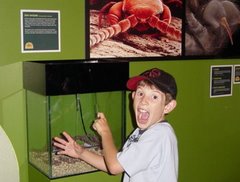Gave a paper at Museums and the Web 2008 looking at some of the ways on-line users have been classified. Again, when at the Museum of the Confederacy we were talking about on-line users and I got to thinking about some of the ways we have "classified" physical visitors and could they be applied to the on-line user as well? I was reminded of something that George McDonald (I think it was) said some time ago about visitors being streakers, strollers and students, which has many resonances with both physical and on-line audiences. George Hein, in his 1998 book Learning in Museums, reported on the following ways that visitors had been grouped (which is useful to re-visit at this time):
Higgins (1884)
- Students
- Observers
- Loungers
- Emigrants
Wolf & Tymitz (1978)
- The commuter – use the hall to get from one entry point to the exit
- The nomad – casual visitor
- The cafeteria type – interested visitor who treats museum like a cafeteria as they search for objects or exhibitions of interest
- The VIP – very interested person
Falk (1982)
- Serious shoppers – come with a clear predetermined notion of what want to see
- Window shoppers – come "to do" the museum
- Impulse shoppers – discover one or more exhibits that are interesting and become more engaged than first planned
Veron & Lavasseur (1989)
- Ants – move methodically from object to object
- Butterflies – move back & forth, alight on some displays
- Grasshoppers – chose specific objects and hop from one to the other
- Fish – glide in and out of exhibitions with few stops
Mia Ridge in recent a blog post suggests we could help visitors lose themselves more so than we do now. While she was talking about on-line audiences, the principle is totally the same for physical visitors. I did find in my doctoral study, however, that we are all different (no surprise there!) and that some love getting lost while others want to get in and then out quickly with what they need and that these preferences are fluid. It's all related to what Csikszentmihihalyi and Hermanson suggested that if a museum visitor was both interested and engaged in an exhibition they would be ready to experience an intrinsically rewarding, optimal experience, which they called flow '... a state of mind that is spontaneous, almost automatic, like the flow of a strong current. ... In the 'flow' state, a person is unaware of fatigue and the passing of time - hours pass by in what seems like minutes. This depth of involvement is enjoyable and intrinsically rewarding.' (1995).
Reflecting on all this I still think the framework of streakers, strollers and students is something worth further thought for both the physical and online experience, coupled with an understanding of the power of the 'flow'...



No comments:
Post a Comment